'Dambuster' Sergeant Robert Jack Henderson
Robert Jack Henderson, or Bob as he was known to family and friends, was born at 123 Tarbrax to John & Kate Henderson on 17th June 1920. His father John had served in WW1 in the Royal Scots and had been badly wounded and was discharged in 1917. He and Kate were married in 1919 and the below image (LVSAV1998.018.005) clearly shows John’s Silver War Badge which was given to those who had been discharged early from the army to wear on their civilian clothing.

In 1925 the mine at Tarbrax closed and the family moved to West Calder, with John working at Westwood Oilworks. Bob was educated at “Wee School” at West Calder and then attended West Calder High School, leaving at 14 to work as a mine haulier at Young’s Addiewell Works before enlisting in the RAF in 1937, aged 17.
In 1942 he was selected to train as a Flight Engineer on the Lancaster planes, which were the most successful British heavy bomber of World War Two. On qualification Bob was posted to 57 Squadron at RAF Scampton where he flew 16 missions with Flight Lieutenant George Curry. In early April 1943 Bob volunteered to join a new top secret squadron which was soon to become 617 Squadron, the legendary ‘Dambusters’.
On the night of 16-17 May 1943, Wing Commander Guy Gibson led 617 Squadron of the Royal Air Force on a bombing raid to destroy three dams in the Ruhr valley, the industrial heartland of Germany. The mission was codenamed Operation 'Chastise'. As the dams provided vital water supply for the surrounding areas, they were fiercely protected by anti-aircraft guns and torpedo nets under the water. However, the squadron had a new secret weapon which was a bomb that could bounce on water.
On the night, 19 Lancasters set off carrying 133 men. 53 of them were killed and 3 became prisoners of war. At ground level, around 1300 people were killed by the flooding and although the impact on industrial production was short-lived, the raid was a great morale booster for the British.
Joining Flight Lieutenent David Shannon’s crew Bob flew 18 missions (including ‘Operation Chastise’) and strikes against transport and communications hubs, industrial units and factories, and V-1 Rocket sites. In one raid on the Dortmund-Ems Canal in Germany, of the eight Lancasters which set off, Bob’s was one of only three which returned. By the time Wing Commander Leonard Cheshire took command of the Squadron in November 1943, only five of the original 19 Dambuster crews remained.
Bob was a big man, at over 6’4” he was the tallest in the Squadron and affectionately known as ‘Lofty’ to his comrades. In the squadron image above, he is shown in the middle of the back row, towering above the rest of his squadron!
Distinguished Flying Medal
In April 1944 Bob was Commissioned and recommended for the Distinguished Flying Medal.
The Citation for this reads:
The Distinguished Flying Medal Register for the Second World War:
with official recommendation details ~
Henderson, Robert Jack 544401 Flight Sergeant, No. 617 Squadron
London Gazette 30/6/1944 Sorties 33, Flying hours 218.55
Flight Engineer Air2/9015
Flight Sergeant Henderson has completed 33 operational sorties as a
Flight Engineer. He has been operating since February 1942 and
has taken part in attacks on targets of major importance in Germany,
France and Italy. In March 1943 he volunteered to join a special duties
squadron and was a member of the force which attacked the German
dams so successfully in May of that year. Since then he has completed a
further 17 sorties including low-level night attacks on the Dortmund-
Ems canal and the Antheor viaduct and several other targets of a
particularly hazardous nature. Several times, the aircraft in which
Flight Sergeant Henderson has been flying has been subjected to intense
opposition from the enemy defences. Never once has he flinched or
wavered but has always continued to carry out the job in hand in a quiet
and courageous manner. He has thereby been an example and source of
inspiration to all his crew. His great courage and determination together
with his unbounded energy merit the highest praise and he is therefore
strongly recommended for the award of the Distinguished Flying Medal.
(10th April 1944)
Bob flew his last mission with David Shannon on the D-Day diversion, ‘Operation Taxable’, on 6th June 1944. Joining Flt Lt Terry Kearns crew he flew a further six missions before transferring in August 1944 to 1654 Heavy Conversion Unit as an instructor training aircrew.
In May 1948, having flown some 40 missions and his war service completed, Bob was demobbed from the RAF with the war rank of Flight Lieutenant, only to re-join three weeks later as a Sergeant. He served in various stations in England, Rhodesia, Scotland (RAF Turnhouse), Malta and Cyprus where, on 18th February 1961, Bob died of a heart attack, aged 40. He is buried at the Dhekelia Military Cemetery in Cyprus.
In 2021 in a service to commemorate Bob in Tarbrax, a bench was unveiled outside the local Community Centre.
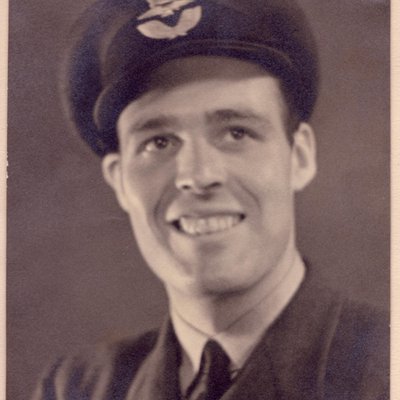
Bob Henderson. Courtesy of Christopher and Debby Henderson.
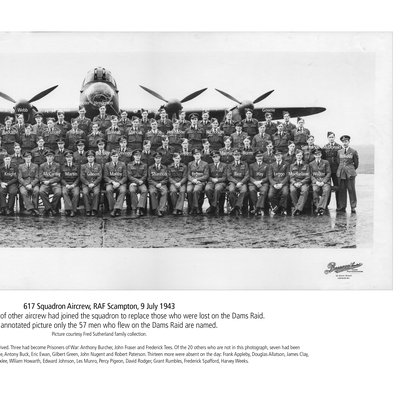
617 Squadron of the Royal Air Force with Bob Henderson in the middle in the back row. Courtesy of Charles Foster.
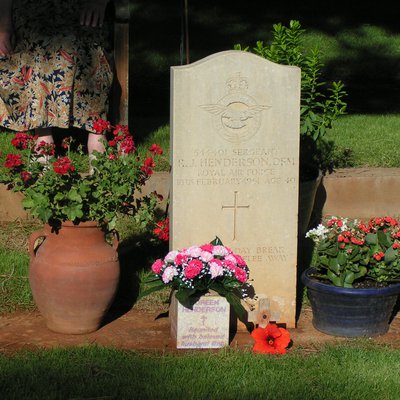
Bob Henderson's grave in the Dhekelia Military Cemetery in Cyprus. Courtesy of Christopher and Debby Henderson.
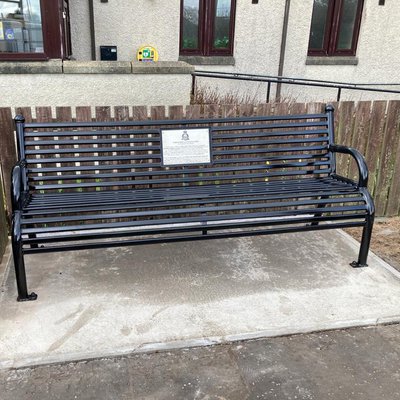
Memorial bench to commemorate Bog Henderson in Tarbrax. Courtesy of Meg Stenhouse.
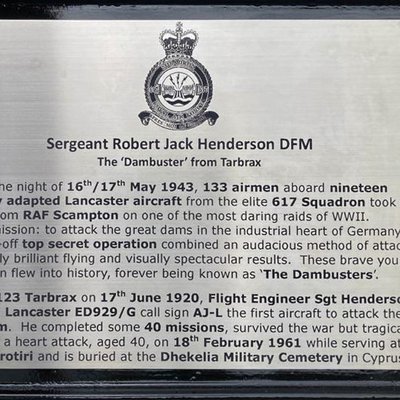
Plaque on memorial bench to commemorate Bog Henderson in Tarbrax. Courtesy of Meg Stenhouse.